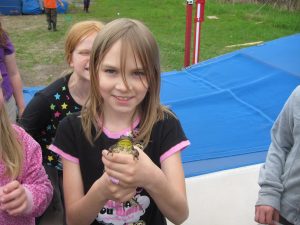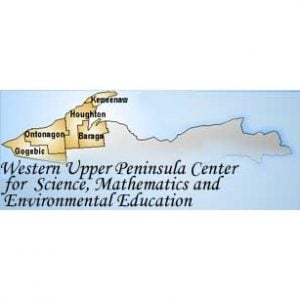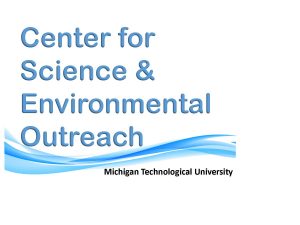 Using the outdoors as a classroom is a great way to get students excited about science and make connections to the real world!
Using the outdoors as a classroom is a great way to get students excited about science and make connections to the real world!
Since 2001, the Western Upper Peninsula Center for Science, Math & Environmental Education, in partnership with the Center for Science & Environmental Outreach at Michigan Technological University, offers outdoor learning experiences in science and environmental education for K-12 students in the five western counties of the Upper Peninsula.
Field trip activities enhance classroom learning and are correlated to Michigan Grade Level Content Expectations for Science and Math.. During the activities, students utilize many science and math skills such as observing, predicting, data collecting, recording, graphing, analyzing and drawing conclusions.
REGISTER NOW
Teachers should complete a Field Trip Request Form online. On the form, select a program, several dates, and a
location. Your school is encouraged to schedule multiple field trips on the same day for different classes at different
times. After we receive your request form, we will schedule your field trip and send you a confirmation letter.
Field trips are available to schools in the CCISD and GOISD school districts.
Cost: The field trips are $30 per class (up to 30 students). The CCISD will invoice each school at the end of
the season for the total number of field trips provided for each school during that season.
Program Descriptions
Please click on the activity title for a sample lesson plan. These plans are a rough idea of what teachers can expect form a lesson. Content can be customized according to class needs or Teacher/Instructor discretion
GRADE K
Warm Earth ½-1 hr
Students will participate in simple tests to help them understand that the sun heats up some earth surfaces more than others. They will be challenged to find warm areas and cool areas and compare them to discover why they differ and how this may affect plants or animals. Finally, they will design a structure to help keep a warm area cool. Standards addressed: K-PS3-1, K-PS3-2, K-LS1-1
Spring Alive! ½-1 hr
Students will make observations of plants and signs of wildlife to discover how both can change the environment to meet their needs. Can we find young plants pushing up through dead leaves or pavement? How about animal holes in trees or the ground? Students will make connections between living things changing their surroundings to help them survive. Standards addressed: K-LS1-1, K-ESS2-2, K-PS3-1
GRADE 1
AnimalLifeCycles
What is metamorphosis? Students will explore the life cycles of familiar wildlife and understand that living things grow and change. They will go on a hunt to find small insects and determine if they are adults or not. Standards addressed: 1-LS3-1
Sounds of Nature ½-1 hr
The outdoors are alive with sounds! Students will hunt to find objects that make sounds, such as leaves rustling, grasses blowing, birds singing, or water flowing. Then we’ll explore common objects that vibrate to make sound: strings, grass whistles, rubber bands and learn that even our voices and bird songs are created by vibrating parts within us. Finally, we’ll go on a bird hunt to see if we can find singing birds. Standards addressed: 1-PS4-1
GRADE 2
Gr.2 Frog-tastic
Students will participate in a variety of activities followed by a search for frogs. Students will describe the basic requirements, adaptations, and life cycle of frogs. Standards addressed: 2-LS4-1
Who Lives in a Tree? ½-1 hr
Trees provide food and shelter to many animals. Students will develop an awareness of trees and some of the animals that live in them and make connections as to how plants help animals and animals help plants by pollination or by distributing seeds. They will also be challenged to develop a device using objects in nature that models how animals pollinate flowers. Standards addressed: 2-LS2-2, 2-LS4-1, K-2-ETS1-3
GRADE 3
Insect Sampling 1½ hrs
How do scientists sample insects? Are sampling methods different for terrestrial vs. aquatic insects? What are the life cycles of different insects? How do insects find their mates? Students will answer these questions as they collect and study insects from terrestrial or aquatic habitats. Standards addressed: 3-LS1-1
What’s For Dinner? 1½ hrs
Students will learn about predator/prey relationships and strategies animals have developed to avoid being eaten. They will discover that some animals of the same species are better at surviving because they have slightly different characteristics that help them. They will define producers and consumers as they examine food chains and food webs. Standards addressed: 3-LS2-1, 3-LS4-3, 3-LS4-2
GRADE 4
Wetland Ecology 1½ hrs
Students will investigate wetlands by studying the soil, plants, and hydrology. Students will be able to describe the essential components of a wetland and classify them. They will also learn why wetlands are such important ecosystems. Standards addressed: 4-ESS3-1, 4-LS1-1
The Secret Life of Bees 1½ hrs
Students will learn the difference between bees, wasps and hornets. They will discover that bees have fascinating lives due to their ability to sense, process and respond to information in unique ways. They will also get an up close look at a honeybee hive. Bee behavior will be further understood through outdoor games and a nature hike to observe important plants for bees. Standards addressed: 4-LS1-1, 4-LS1-2
GRADE 5
Soil Science 1½ hrs
What is soil? How can soil be described according to texture? Does water move through different soil types faster? What kinds of organisms live in soil? Students will conduct an investigation to describe various soil types and compare percolation rates. Standards addressed: 5-PS1-3, 5-ESS2-1
Birds in Spring 1½ hrs
Spring is a busy time for birds. They are returning from migration, mating and building nests. Students will listen and look for birds and record the data, practice using binoculars and learn the names of some common birds.
GRADE 6
Pond (or Stream) Sampling 1½ hrs
Students collect data to discover fauna, and flora of a pond. Students will sample pH, dissolved oxygen, and temperature. We will discuss ways to make sure we are not negatively impacting the delicate ecosystem of a pond. Standards addressed: MS-LS2-1
Invasive Species 1½ hrs
What are invasive species? Are there any in the surrounding area? How can we slow down their invasion? Students will learn about some of the native, exotic and invasive species in our area and then investigate the surrounding area, looking for them.
_________________________________________________________________________________________________________________
Important information __________________________________________________________________________________________________________________________________________________
Appropriate Dress:
The weather can be very unpredictable at this time of the year. Please have your students dress for the weather conditions! We recommend boots for wet, muddy conditions. Some rubber boots will be available for field trips to a wetland or pond.
Locations for Spring Field Trips:
- Michigan Tech Recreational Trails
- Nara Chalet and Preserve
- Maasto Hiito Trails
- Lake Linden-Hubbell School Forest
- McClain State Park
- Calumet Waterworks Park
- Calumet Lake/ Calumet Lions Park
- Black Creek Nature Sanctuary
- Baraga School Forest
- Ford Center and Forest (Alberta)
- Bessemer City Park
- Norrie Park
- Ottawa National Forest Visitor Center
- Lake Perrault
- Your school
Cancellation Policy: the Center will not cancel any field trips due to weather, it is the responsibility of the teacher to
decide if a field trip should be cancelled. To cancel a field trip, please call the Field Trip Coordinator at (906)
370-1052 at least 2 hours in advance (3 hours for Gogebic/Ontonagon schools).
For more information, contact:
Brian Doughty, Field Trip Coordinator
Email: bwdoughty@mtu.edu
Phone: 906-487-3341 (office) or 248-798-4382 (cell)
The Western U.P. Center for Science, Mathematics & Environmental Education is a partnership of Copper Country & Gogebic-Ontonagon
Intermediate School Districts and the Michigan Tech Center for Science & Environmental Outreach serving schools and communities in
Houghton, Baraga, Gogebic, Ontonagon and Keweenaw Counties. The Center’s mission is to enhance the teaching and learning of Science,
Technology, Engineering, and Math (STEM).
Field Trip Financial Support
The Outdoor Science Investigation Field Trip Program has been funded since 2008 with a grant from the Wege Foundation to Michigan Tech.
In 2012 and 2015, snowshoes were purchased with support from the Keweenaw Community Foundation and the MEEMIC Foundation,
respectively. In 2016, another grant from the Keweenaw Community Foundation is funding technology to support outdoor investigations.
The field trip program is coordinated by the Michigan Tech’s Center for Science and Environmental Outreach and the Western UP Center for Science, Math and Environmental Education. It is funded in part by the Michigan Stem Partnership and the Wege Foundation.


